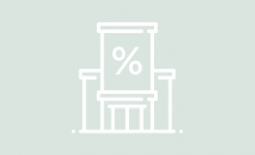Press release №43. The base rate remains unchanged at 9,25%
The annual inflation is formed below the expectations of the National Bank. The real GDP growth is picking up gradually. In light of the current decision on the base rate, inflation is to develop within the target corridor of 4-6% in 2019-2020.
Further decisions on the base rate will be made based on the balance of domestic and external risks, which in turn will determine the level of actual inflation and its alignment with the target.
In November 2019 the annual inflation amounted to 5.4% (5.5% in October 2019) and between May and November this year has been stable in a narrow corridor of 5.3 – 5.5%. Food prices that stabilized at October level and amounted to 9.7% continue to make the largest contribution to the headline inflation. The price increase of meat, bakery products and cereals, which grew up by 13.4% and 15.5% this year, respectively, remains the main cause of food inflation. The ongoing slowdown in the growth of prices for non-food items to 4.8% and paid services to 0.6% has a restraining effect on inflation.
Household inflation expectations in November this year rose marginally to 5.8% (5.6% in October 2019) amidst the higher growth in food prices. According to the latest survey, the proportion of respondents expecting persisting or higher consumer price increase over the next 12 months was 54.7% (56.4% in October 2019).
Expanding consumer demand and accelerating growth of economic activity remain the main inflation drivers. A growth of household real disposable income reached 6.4% between January and September 2019. Real wages accelerated to 12% in the 3rd quarter of 2019. Meanwhile the growth observed in all major sectors of the economy. Compared to the previous year, the household consumption is propped up by increased budget spending on social transfers and wages, as well as high growth rate of consumer lending (23.8% in annual terms in October 2019).
From January to October this year, the short-term economic indicator increased by 4.7% in annual terms. A positive contribution was made by the growth in construction by 12.7%, trade – by 7.5%, transport - by 5.6%, mining and manufacturing- by 3.7% and 3.3%, respectively. The expansion of investments between January and October 2019 amounted to 8.2%.
In 2019 the economic growth is estimated by the National Bank at 4.2%, in 2020 – 3.8%. The growth of consumer demand amid the increase in household real disposable income, an increase in investment demand as a result of the of infrastructure and investment projects implementation, an increase in exports due to the increase in oil and gas condensate production are anticipated to be the major drivers of the economic growth.
The impact of external sector factors is relatively neutral. The price of Brent crude oil remains relatively higher than the level used in the base scenario. This year the 11 months average price amounted to 64.1 US dollars per barrel (72.9 US dollars per barrel as of 11 months of 2018). In 2020, the price of oil will be forming close to current levels amid a weak growth of the global economy. The FAO food price index increased by 9.5% in November 2019, driven by higher prices for dairy products, meat, and vegetable oils. A moderate uptick in world grain prices is expected amidst an increase in consumption as a consequence of the reduction in stocks.
The external monetary conditions contribute to the easing of the inflationary background. The central banks’ policies of reducing interest rates and expanding various stimulus measures proceed. Inflation in the countries - trading partners amidst a slowing inflation in Russia and an ongoing moderate consumer price growth rate in the EU countries has a disinflationary impact on domestic prices in Kazakhstan.
The annual inflation is projected within the target range of 4-6% at 5.5-5.7% at the end of 2019 with a slowdown by the end of 2020 to 5.0-5.5%. In the 1st quarter of 2020, the shortterm inflationary risks realization and the acceleration of inflation to the upper bound of the target range are considered possible. This is due to the increase in regulated tariffs for paid services for the general public, as well as increase in prices for certain types of food items. In the medium term, the extension of the fiscal stimulus and the output gap, which is estimated by the National Bank as positive, will remain the main drivers, determining the dynamics of inflation in 2020.
Current monetary conditions are assessed as weakly restraining due to the need of proactive measures to limit the impact of the widening current account deficit on inflation and exchange rate expectations.
The next decision on the base rate will be announced on February 3, 2019, at 15:00 NurSultan time.




